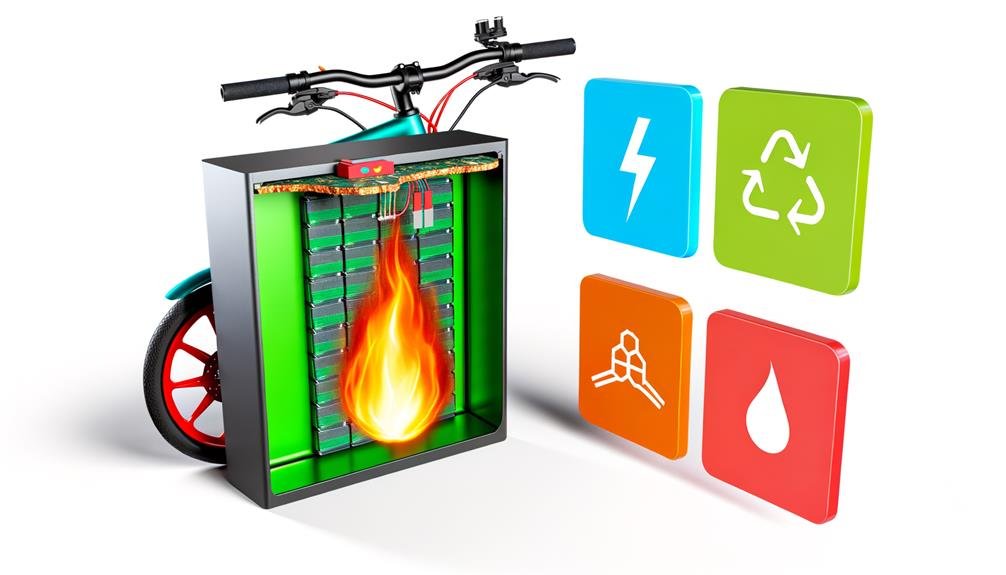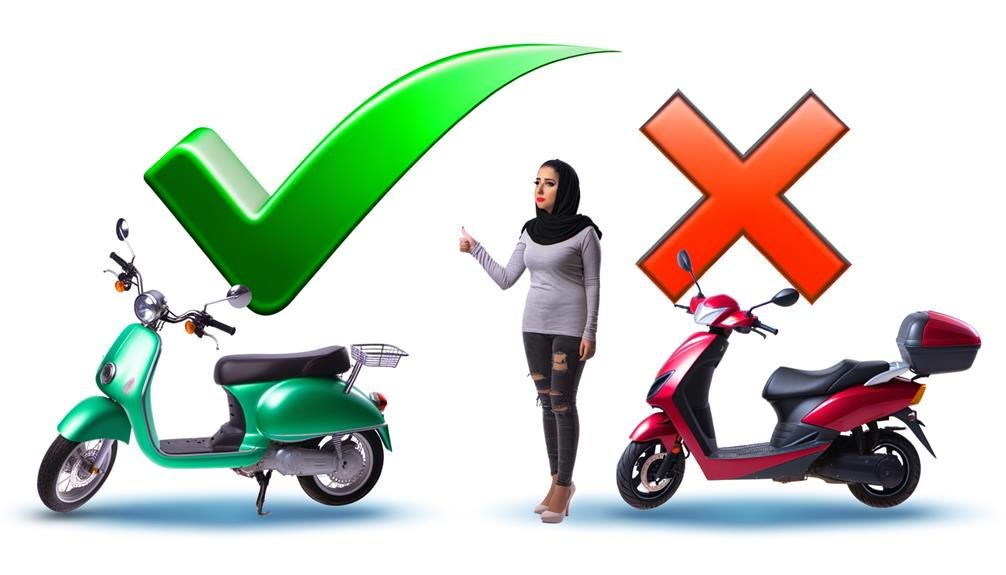Charles Miller is a veteran bike enthusiast with over 12 years of experience dealing with bikes as a mechanic. Despite immense love and expertise for...
Are we truly safe when we ride our e-bikes, or could the battery be a ticking time bomb? As the popularity of electric bikes surges, so too does the urgency of addressing this question.
With stories of battery fires making headlines, it's high time we examined the safety of e-bike batteries. Despite the alarming incidents, many experts argue that these batteries, when used properly, are generally safe.
So, let's investigate the truth of the matter – are e-bike batteries indeed a cause for concern or are they just victims of a few unfortunate occurrences? Stick with us as we unravel this complex issue.
Key Takeaways
- Ebike batteries should be purchased from reputable sources to ensure quality and safety.
- Regular inspection and maintenance of batteries is important to prevent damage and potential fires.
- Following manufacturer's guidelines for charging and storage reduces the risk of accidents.
- Investing in quality lithium batteries and following safety protocols can help prevent battery-related incidents.
Understanding Ebike Battery Composition
Diving into the heart of Ebike batteries, it's crucial to note that they often employ lithium-ion cells, prized for their high energy density and lightweight characteristics. It's like peeling back the layers of an onion; each component reveals another essential element of what's inside an E-bike, creating the electrified riding experience we all love.
Let's delve deeper into understanding ebike battery composition. The heart of E-bike batteries lies in their battery cells, which take various forms such as cylindrical, prismatic, and pouch. Each shape offers unique advantages, providing both energy storage and design flexibility. These battery cells come together to form battery packs, providing the power needed to propel our E-bikes forward.
But let's not forget about the battery management system (BMS), an unsung hero that regulates the performance and safety of the battery. It's like the conductor of an orchestra, ensuring that each part plays in harmony.
The composition of E-bike batteries typically includes an anode, a cathode, and an electrolyte. These elements facilitate the ion flow during charging and discharging, ensuring optimal performance and safety. As we journey together in the E-bike community, understanding these components is key to appreciating the technology that powers our rides.
Major Brands Vs. Unbranded Batteries
After dissecting the complex composition of Ebike batteries, it's now crucial we shift our focus to scrutinize the differences between batteries from major brands and those that are unbranded. As a community dedicated to safe and efficient E-bike usage, we need to make informed decisions when it comes to purchasing our batteries.
Major brands prioritize safety, sourcing their lithium-ion battery components from reputable manufacturers. This ensures you get a safe battery that's been properly tested and accredited. On the other hand, unbranded or DIY batteries may use cells from smaller, non-premium manufacturers, potentially compromising quality and performance.
| Major Brands | Unbranded Batteries |
|---|---|
| Reputable manufacturers | Non-premium manufacturers |
| Safety prioritized | Safety may be compromised |
| Properly tested & accredited | Lower quality & performance |
When you purchase your E-bike, remember that cheaper batteries, often manufactured in the Far East and later branded by different companies, may affect performance and cycle life. Major brands also provide compatible, accredited charging solutions, enhancing your E-bike experience. Safety isn't just a priority, it's a community value. So, let's choose our batteries wisely. Major brands vs. unbranded batteries: the choice is clear.
Causes of Ebike Battery Fires

As we shift our focus to the causes of ebike battery fires, it's crucial to understand that numerous factors can contribute to these incidents.
Often, fires stem from low-quality products, compromised safety standards, or damaged batteries.
However, the inherent risks of lithium-ion batteries, particularly larger ones, can't be overlooked due to their propensity to release energy as heat.
Ebike Battery Fire Triggers
Unseen dangers lurk within the heart of your ebike, with improper handling and maintenance often serving as prime triggers for ebike battery fires. As part of our community, it's crucial to understand these ebike battery fire triggers to minimize fire risk and ensure a safe battery experience.
| Fire Triggers | Prevention |
|---|---|
| Damaged Batteries | Avoid physical impacts, inspect regularly |
| Overcharging | Use manufacturer recommended chargers |
| Extreme Temperatures | Store in cool, dry place |
| Short-circuiting | Keep battery terminals clean and protected |
| Poor Quality Batteries | Invest in quality, lithium batteries |
Battery fires can be devastating, but by identifying potential triggers, we can help prevent them. Remember, a damaged battery is a significant fire risk. Let's strive for safe, enjoyable ebiking by understanding and mitigating these triggers.
Preventing Battery-Related Incidents
Taking steps to prevent battery-related incidents, particularly those resulting in fires, is paramount when dealing with ebikes, as multiple reports highlight the risks associated with products from manufacturers that skimp on battery design and testing.
E-bike Battery Safety is more than just a catchphrase; it's a lifestyle that requires vigilance and knowledge.
- Safe charging:
- Charge your E-bike in an open, well-ventilated area away from flammable materials.
- Regularly check for any physical damage or irregular charging behavior.
- Being prepared:
- Arm yourself with a fire extinguisher that's suitable for electrical fires.
- Have your battery checked by a repair expert if you notice any damage.
Embracing these precautions will go a long way in preventing battery-related incidents, ensuring a safe battery experience for all.
Minimizing Battery Fire Risks
While it's crucial to enjoy the benefits of e-bikes, it's equally important to prioritize safety by purchasing from reputable manufacturers known for their focus on safety and quality control. Investing in ebike batteries that meet stringent safety standards and come with a robust battery management system significantly helps in minimizing battery fire risks.
Following the manufacturer's guidelines for proper battery usage and charging is another crucial step. These guidelines often include essential instructions on how to store your E-bike battery safely, such as avoiding exposure to extreme temperatures.
We should also make a habit of regularly inspecting and maintaining our e-bike batteries. If you notice any issues, don't hesitate to seek professional assistance. It's important to remember that a safe battery is a well-maintained battery.
| Dos | Don'ts |
|---|---|
| Purchase from reputable manufacturers | Handle damaged or unknown batteries |
| Follow manufacturer's guidelines | Use unbranded or DIY batteries |
| Regularly inspect and maintain | Expose to extreme temperatures |
Lastly, be cautious when handling damaged or unknown batteries. Steer clear of unbranded or DIY batteries which often compromise on quality and performance. Good practice and vigilance are key to ensuring our e-bike experience remains enjoyable and safe.
Battery Safety Standards in Ebikes

Building on our understanding of individual safety practices, we must also consider the broader framework of industry standards that guide e-bike battery safety, including crucial certifications and design considerations.
Battery safety standards in ebikes and escooters have been established to ensure a safe battery operation and minimize risk.
- Look for certifications:
- UL certification is a reliable indicator of safe batteries and chargers. UL 41 is a standard specifically addressing ebike battery safety.
- The CE mark is also essential, indicating conformity with health, safety, and environmental protection standards for products sold within the European Economic Area.
- Proper handling and storage:
- Batteries should be checked regularly for damage. Damaged batteries pose a significant fire risk, so it's crucial to have them inspected by experts.
- Lithium-ion batteries, which hold more energy than conventional batteries, should be disposed of at qualified recycling centers to limit risks.
These safety standards and guidelines ensure that the ebike community can confidently ride knowing that their batteries are secure and reliable.
As users, we've a shared responsibility to follow these guidelines for our safety and the longevity of our ebikes.
Dos and Don'ts for Ebike Battery Safety
Navigating the do's and don'ts of e-bike battery safety, we need to prioritize purchasing from trustworthy sources, recognizing crucial certifications, and ensuring proper handling of these power sources.
Buying batteries from reputable stores or trusted websites is the first step towards a safe battery for our electric bikes. We can't underestimate what's inside an E-bike battery; it's the powerhouse of our Mountain Biking adventure hence, quality is a non-negotiable aspect.
Noticing a damaged battery pack? Stop using or charging it immediately. It's a smart move to have it checked by a repair expert, mitigating any fire risk.
Certifications matter. Look for UL or the CE mark when buying batteries. These certifications are our assurance that safety and testing standards have been met.
Proper charging and storage of batteries are equally important. We must use chargers specifically designed for our e-bike battery and follow the manufacturer's guidelines. This practice minimizes fire risk, ensuring a safe and enjoyable Mountain Biking experience.
Lastly, having a fire escape plan and necessary safety measures while charging batteries is wise. We feel secure knowing we've done our part in safeguarding our biking escapades.
Frequently Asked Questions
Are Batteries on Electric Bikes Safe?
We're confident that ebike batteries are safe, considering factors like battery lifespan, types, manufacturer standards, and proper maintenance practices. Weather impact and correct storage options further ensure their safety. Always choose reputable brands for assurance.
How Do I Ensure My E-Bike Battery Safety?
We ensure our e-bike battery safety through regular inspection, proper storage, and handling mishaps swiftly. Using chargers designed for them is crucial, as is correct battery disposal. Battery maintenance is a top priority for us.
How Do You Prevent a Lithium Battery Fire?
We're always cautious with our lithium battery handling. We maintain proper temperature management, use fireproof containers for storage, follow safe charging practices, and have fire extinguishers ready. We're also mindful about proper battery disposal.
How Do You Prevent Fires on Ebikes?
We're proactive in preventing ebike fires. We use fireproof storage, supervise charging, inspect batteries, and use quality chargers. We regulate temperature and maintain regularity in upkeep. It's how we ensure our ebike experiences are safe.
Conclusion
In the grand scheme of things, ebike batteries are a safe bet, if we stick to the rules. Like a well-rehearsed dance, we must follow the steps – choose reputable brands, handle with care, and stay informed.
With these safeguards, ebike batteries won't turn into ticking time bombs. So, let's embrace this electric revolution, armed with knowledge and understanding, ensuring our ride is nothing short of electrifying!

Charles Miller is a veteran bike enthusiast with over 12 years of experience dealing with bikes as a mechanic. Despite immense love and expertise for his Tacoma, he rides his Trek Ebike more. Anytime you meet him, you’ll either hear him talking about Bikes, or writing about all things bikes and cars on this blog.
More Posts


